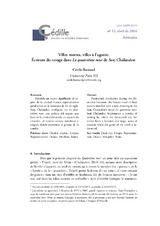Mostrar el registro sencillo del ítem
Villes mortes, villes à l’agonie. Écriture du ravage dans Le quatrième mur de Sorj Chalandon
| dc.contributor.author | Barraud, Cécile | |
| dc.date.accessioned | 2019-03-15T09:31:37Z | |
| dc.date.available | 2019-03-15T09:31:37Z | |
| dc.date.issued | 2016 | |
| dc.identifier.issn | 1699-4949 | |
| dc.identifier.uri | http://hdl.handle.net/10396/18186 | |
| dc.description.abstract | Dándole un nuevo significado al tópico de la ciudad muerta, especialmente productivo en la literatura de fin de siglo, Sorj Chalandon configura, en Le quatrième mur, una poética del saqueo que hace de la ciudad devastada un espacio de creación, al mismo tiempo novelesco y trágico, donde reinventar el género de la tumba. | es_ES |
| dc.description.abstract | Particularly productive during the finde-siècle literature, the literary motif of dead cities is instilled with a new meaning in the Sorj Chalandon’s novel Le quatrième mur. Sorj Chalandon implements a poetics of sacking by which the devastated city becomes both a fictional and tragic space of creation where the genre of the tomb is reinvented. | es_ES |
| dc.format.mimetype | application/pdf | es_ES |
| dc.language.iso | fra | es_ES |
| dc.publisher | UCOPress | es_ES |
| dc.rights | https://creativecommons.org/licenses/by/4.0/ | es_ES |
| dc.source | Çedille 12, 59-69 (2016) | es_ES |
| dc.subject | Ciudad muerta | es_ES |
| dc.subject | Utopía | es_ES |
| dc.subject | Representación | es_ES |
| dc.subject | Drama | es_ES |
| dc.subject | Metáfora | es_ES |
| dc.subject | Ruina | es_ES |
| dc.subject | Dead city | es_ES |
| dc.subject | Utopia | es_ES |
| dc.subject | Representation | es_ES |
| dc.subject | Metaphor | es_ES |
| dc.subject | Ruin | es_ES |
| dc.title | Villes mortes, villes à l’agonie. Écriture du ravage dans Le quatrième mur de Sorj Chalandon | es_ES |
| dc.type | info:eu-repo/semantics/article | es_ES |
| dc.relation.publisherversion | http://www.uco.es/ucopress/ojs/index.php/ced | es_ES |
| dc.rights.accessRights | info:eu-repo/semantics/openAccess | es_ES |

